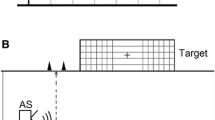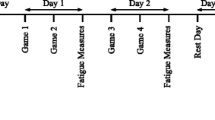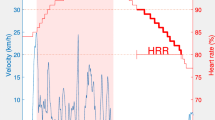Abstract
The role of the referee is far from minimal in the economy of soccer, as very often, particularly in professional soccer, a wrong judgment may have profound implications on the outcome of the game. In this regard, a better knowledge of soccer refereeing can obviously benefit the game. Recent studies have shown that during a competitive match, an elite soccer referee may cover 9–13km attaining approximately 85–90% and approximately 70–80% of maximal heart rate and maximal oxygen uptake (V̇O2max), respectively. Of the total distance covered about 4–18% is covered at high intensity. Blood lactate concentration has been reported to be in the range of 4–5 mmol/L; however, during competitive matches, blood lactate concentrations as high as 14 mmol/L have been observed. This figure is similar to that extensively reported for soccer players, specifically paralleling that observed in midfield players. However, compared with players, referees are 15–20 years older, often have a non-professional status and cannot be substituted during the game. Furthermore, this important physical stress superimposes onto a high perceptual-cognitive workload throughout the entire game. In relation to fitness status, referees possess V̇O2max values somewhat lower than the players they officiate, with mean values in the range of 44–50 mL/kg/min. However, the methods used by the Federation Internationale de Football Association and the Union of European Football Associations to test referee fitness need to be changed as the current fitness tests do not relate to match performance. More task-specific tests such as the Yo-Yo Intermittent Recovery Test (YYIRT) have been devised and validated for use with referees. Given that aerobic performance is positively correlated with match performance, it is important that referees are trained to improve their ability to cover large distances during a match and also to repeat high-intensity efforts. A number of studies have shown large improvements in YYIRT performance following both short-term (12 weeks) and long-term (16 months) high-intensity interval training. Future research needs to focus on a number of important areas including the decision-making ability of referees when officiating under different conditions, such as high thermal strain, and the impact of age on both physical and mental performance.


Similar content being viewed by others
References
Peiser B, Minten, J. Soccer violence. In: Reilly T, Williams AM. editors. In: Science and soccer. 2nd ed. London: Routedge, 2003: 230–41
Reilly T. Energetics of high-intensity exercise (soccer) with particular reference to fatigue. J Sports Sci 1997; 15: 257–63
FIFA. Where it all began [online]. Available from URL: http://www.fifa.com [Accessed 2002 Sep 9]
Reilly T, Gilbourne D. Science and football: a review of applied research in the football codes. J Sports Sci 2003; 21: 693–705
Stølen T, Chamart K, Castagna C, et al. Physiology of soccer: an update. Sports Med 2005; 35 (6): 501–36
Tonally D. Physiological characteristics of elite soccer players. Sports Med 1993; 16: 80–96
Shephard RJ. Biology and medicine of soccer: an update. J Sports Sci 1999; 17: 757–86
Reilly T. An ergonomics model of the soccer training process. J Sports Sci 2005; 23 (6): 561–72
Mohr M, Krustrup P, Bangsbo J. Fatigue in soccer: a brief review. J Sports Sci 2005; 23 (6): 593–9
Impellizzeri FM, Rampinini E, Marcora SM. Physiological as sessment of aerobic training in soccer. J Sports Sci 2005; 23 (6): 583–92
Ekblom B. Applied physiology of soccer. Sports Med 1986; 3: 50–60
Svensson M, Drust B. Testing soccer players. J Sports Sci 2005, 23 (6): 601–18
Hoff J, Helgerud J. Endurance and strength training for soccer players: physiological considerations. Sports Med 2004; 34 (3): 165–80
Hoff J. Training and testing physical capacities for elite soccer players. J Sports Sci 2005; 23 (6): 573–82
Abt GA, Dickson G, Mummery WK. Goal scoring patterns over the course of a match: an analysis of the Australian National Soccer League. In: Spink; W, Reilly T, Murphy A, editors. Science and football IV. London: Routledge, 2002: 106–11
Eissmann HJ. The 23rd man: sport medical advice for football referees. Leipzig: Gersöne-Druck, 1996
Féderation Internationale de Football Association. Laws of the game 2005. Zurich: Féderation Internationale de Football Association, 2005
Helsen W, Bultynck JB. Physical and perceptual-cognitive demands of top-class refereeing in association football. J Sports Sci 2004; 22: 179–89
Bangsbo J. The physiology of soccer: with special reference to intense intermittent exercise. Acta Physiol Scand 1994; 151 Suppl. 619: 1–155
Bangsbo J. Time and motion characteristics of competitive soccer. Sci Football 1992; 6 (2): 34–40
Mohr M, Krustup P, Bangsbo J. Match performance of highstandard soccer players with special reference to development of fatigue. J Sports Sci 2003; 21: 519–28
Castagna C, D’Ottavio S, Abt G. Activity profile of young soccer players during actual match play. J Strength Cond Res 2003; 17 (4): 775–80
Asamu T, Togari H, Ohashi J. Analysis of movement patterns of referees during soccer matches. In: Reilly T, Lees A, Davids K, et al., editors. Science and football. London: E & FN Sport, 1988: 341–5
Johnston L, McNaughton L. The physiological requirements of soccer refereeing. Aust J Sci Med Sport 1994; 26 (3/4): 67–72
Catrerall C, Reilly T, Atkinson G, et al. Analysis of work rate and heart rates of association football referees. Br J Sports Med 1993; 27: 153–6
D’Ottavio S, Castagna C. Analysis of match activities in elite soccer referees during actual match play. J Strength Cond Res 2001; 15 (2): 167–71
Krustrup P, Bangsbo J. Physiological demands of top-class soccer refereeing in relation to physical capacity: effect of intense intermittent exercise framing. J Sports Sci 2001; 19: 881–91
Castagna C, Abt G, D’Ottavio S. Activity profile of international-level soccer referees during competitive matches. J Strength Cond Res 2004; 18 (3): 486–90
Harley RA, Tozer K, Doust J. An analysis ofmovement patterns and physiological strain in relation to optimal positioning of Association Football referees. In: Spinks W, Reilly T, Murphy A, editors. Science and football IV. London: Routledge, 2002: 137–43
Castagna C, D’Ottavio S. Effect of maximal aerobic power on match performance in elite soccer referees. J Strength Cond Res 2001; 15 (4): 420–5
Castagna C, Abt G, D’Ottavio S. Relation between fitness tests and match performance in elite Italian soccer referees. J Strength Cond Res 2002; 16 (2): 231–5
Castagna C, Abt G, D’Ottavio S. The relationship between selected blood lactate thresholds and match performance in elite soccer referees. J Strength Cond Res 2002; 16 (4): 623–7
Reilly T. Motion analysis and physiological demands. In: Reilly T, Williams AM, editors. Science and soccer. London: E & FN Sport, 2003: 59–72
Bangsbo J, Norregaard L, Thorso F. Activity profile of competition soccer. Can J Sport Sci 1991; 16 (2): 110–6
Williams AM, Lee D, Reilly T. A quantitative analysis of matches played in the 1991-92 and 1997-98 seasons. London: The Football Association, 1999
D’Ottavio S, Castagna C. Physiological load imposed on elite soccer referees during actual match play. J Sports Med Phys Fitness 2001; 41 (1): 27–32
D’Ottavio S, Castagna C. Physiological aspects of soccer refereeing. In: Spinks W, Reilly T, Murphy A, editors. Science and football IV. London: Routledge, 2002: 144–50
Wisløff U, Helgerud J, Hoff J. Strength and endurance of elite soccer players. Med Sci Sports Exerc 1998; 30 (3): 462–7
Wellman A. The blood lactate response to exercise. Champaign (IL): Human Kinetics, 1995
Reilly T, Brwen T. Exertional cost of changes in directional modes of running. Percept Motor Skills 1984; 58: 49–50
Barley RA, Banks R, Doust J. The development and evaluation of a task specific fitness test for association football referees. In: Spinks W, Reilly T, Murphy A, editors. Science and football IV. London: Routledge, 2002: 76–80
Castagna C, Abt G. Intermatch variation of match activity in elite Italian soccer referees. J Strength Cond Res 2003; 17 (2): 388–92
Ohashi J, Togari H, Isokawa M, et al. Measuring movement speeds and distances covered during soccer match-play. In: Reilly T, Lees A, Davids K, et al., editors. Science and football. London: E & FN Sport, 1988: 329–33
Reilly T. Motion analysis and physiological demands. In: Reilly T, Williams AM, editors. Science and soccer. London: E & FN Sport, 2003: 59–72
Krustrup P, Mohr M, Bangsbo J. Activity profile andphysiological demands of top-class soccer assistant refereeing in relation to training status. J Sports Sci 2002; 20: 861–71
Helgerud J, Engen LC, Wisloff U, et al. Aerobic endurance training improves soccer performance. Med Sci Sports Exerc 2001; 33 (11): 1925–31
Weston M, Brewer J. A study of the physiological demands of soccer refereeing. J Sports Sci 2002; 20: 59–60
Snyder AC, Kuipers H, Cheng B, et al. Overttaining following intensified training with normal muscle glycogen. Med Sci Sports Exerc 1995; 27 (7): 1063–70
Urhausen A, Gabriel HH, Weiler B, et al. Ergometric and psychological findings during overttaining: a long-term follow-up study in endurance athletes. Int J Sports Med 1998; 19 (2): 114–20
Lehmann M, Dickhuth HH, Gendrisch G, et al. Training-overtraining: a prospective, experimental study with experienced ntiddle-and long-distance runners. Int J Sports Med 1991; 12 (5): 444–52
Jeukendrup AE, Hesselink MKC, Snyder AC, et al. Physiological changes in male competitive cyclists after two week; of intensified training. Int J Sports Med 1992; 13: 534–41
Hooper SL, Mackinnon LT, Howard A. Physiological and psychometric variables for monitoring recovery during tapering for major competition. Med Sci Sports Exerc 1999; 31 (8): 1205–10
Bosquet L, Leger L, Legros O. Bloat lactate response to overtraining in male endurance athletes. European J Appl Physiol 2001; 84: 107–14
Halson SL, Bridge MW, Meeusen R, et al. Time course of performance changes and fatigue markers during intensified training in trained cyclists. J Appl Physiol 2002; 93 (3): 947–56
Weston M, Belsen W, MacMahon C, et al. The impact of specific high-intensity training sessions on football referees’ fitness levels. Am J Sport Med 2004; 32 (1 Suppl.): 54–61s
Achten J, Jeukendrup A. Heart rate monitoring: applications and limitations. Sports Med 2003; 33 (7): 517–38
Åstrand P, Rordahl K. Textbook of Work physiology: physiological bases of exercise. 3rd ed. New York: McGraw-Hill, 1986
Castagna C, Abt G, D’Ottavio S. Competitive-level differences in Yo-Yo intermittent recovery and 12 nun run test performance in soccer referees. J Strength Cond Res 2005; 19 (4): 805–9
Rodriguez FA, Iglesias X. The energy cost of soccer: telemetric oxygen uptake measurements versus heart rate-V̇O2 esfimadons [abstract]. J Sports Sci 1998; (16): 484–5
Smith M, Clarke G, Hale T, et al. Bloat lactate levels in college soccer players during match-play. In: Reilly T, Clarys J, Stibbe A, editors. Science and football II. London: E & FN Sport, 1993: 129–34
Salta B, Costill DL. Fluid and electrolyte balance during prolonged exercise. New York: Macmillan, 1988
Sawka MN, Pandolf KB. Effect of body water loss on physiological functioning and exercise performance. In: Gisolfi CV, Lamb DR, editors. Fluid homeostasis during exercise. Carmel (IN): Cooper, 1990: 1–38
Coyle EF. Fluid and fuel intake during exercise. J Sports Sci 2004; 22: 39–55
Maughan RJ, Leiper JB. Fluid replacement requirements in soccer. J Sports Sci 1994; 12: S29–34
Gopinathan PM, Pichan G, Sharma VM. Role of dehydration in heat stress-induced variations in mental performance. Arch Environ Health 1988; 43 (1): 15–7
Davies PD, Cooke CB, King RFGJ. Fluid loss and replacement in English prouder league football players. In: Reilly T, Bangshe J, Hughes MA, editors. Science and football III. London: E. & F.N. Sport, 1996: 54–9
Mustafa KY, Mahmoud ED. Evaporative water loss in African soccer players. J Sports Med Phys Fitness 1979; 19: 181–3
McGregor SJ, Nicholas CW, Lakonry HKA, et al. The influence of intermittent high-intensity shuttle running and fluid ingestion on the performance of a soccer skill. J Sports Sci 1999; 17: 895–903
Nicholas CW, Nuttall FE, Williams C. The Loughborough Intermittent Shuttle Test: a field test that simulates the activity pattern of soccer. J Sports Sci 2000; 18: 97–104
Da Silva AI, Fernandez R. Dehydration of football referees during a match. Br J Sports Med 2003; 37: 502–6
Garganta J, Maia J, Baste F. Analysis ofgoal-scoring patterns in European top level soccer teams. In: Reilly T, Bangsbo J, Hughes M, editors. Science and football III. London: E & FN Sport, 1997: 246–50
Grehaigne YF. Time distribution of goals in soccer: some championships and the 1998 World Cup. In: Hughes M, Tavarez F, editors. IV World Congress of Notational Analysis of Sport. Porto (Portugal): Centre for Team Sports Studies, Faculty of Sport Sciences and Physical Education, University of Porto, 1998: 41–50
Reilly T, Lewis W. Effects of carbohydrate feeding on mental functions during sustained physical work. In: Brown ID, Goldsouth R, Coombes K, et al., editors. Ergonimics international 85. London: Taylor and Francis, 1985: 700–2
Reilly T. Environmental stress. In: Reilly T, Williams M, editor. Science and soccer. Routledge: London, 2003: 165–84
Rontoyannis GP, Stalikas A, Sarros G, et al. Medical, morphological and functional aspects of Greek football referees. J Sports Med Phys Fitness 1998; 38: 208–14
Harband V, Bergson P. Anthropometric and physical capacity characteristics of Brazilian soccer referees and referee assistants. In: Tavarez F, editor. IV World Congress on Notational Analysis of sport. Porto (Portugal): FCDEF-Porto University, 1998: 35
Eissmann HJ, D’Hooghe M. Sports medical examinations. In: Eissmann HJ, editor. The 23rd man: sports medical advice for football referees. Leipzig: Gersone-Druck, 1996: 7–19
Wilmore JH, Costill DL. Physiology of sport and exercise. 2nd ed. Champaign (IL): Human Kinetics, 1999
Castagna C, Abt G, D’Ottavio S, et al. Age-related effects on fitness performance in elite-level soccer referees. J Strength Conditioning Res 2005; 19 (4): 785–90
Bangsbo J, Mohr M, Krustrup P. Physical capacity and match performance of top-class referees in relation to age. J Sports Sci 2004; 22 (6): 485–593
Reilly T, Bangsbo J, Franks A. Anthroponetric and physiological predispositions for elite soccer. J Sports Sci 2000; 18: 669–83
Wisloff U, Castagna C, Helgerud J, et al. Maximal squat strength is strongly correlated to sprint-performance and vertical jump height in elite soccer players. Br J Sports Med 2004; 38: 285–8
Bosco C, Kenu PV. Influence of aging on the mechanical behaviour of leg extensor muscles. Eur J Appl Physiol 1980; (45): 209–19
Ramsbottom R, Brewer J, Williams C. A progressive shuttle run test to estimate maximal oxygen uptake. Br J Sports Med 1988; 22 (4): 141–4
Leger LA, Mercier D, Gadoury C, et al. The nurldstage 20 metre shuttle run test for aerobic fitness. J Sports Sci 1988; 6 (2): 93–101
Kmstrup P, Mohr M, Amstrup T, et al. The Yo-yo Inkrnuttent Recovery Test: physiological response, reliability, and validity. Med Sci Sports Exerc 2003; 35 (4): 697–705
Pate RR, Kriska A. Physiological basis of the sex difference in cardiorespiratory endurance. Sports Med 1984; 1 (2): 87–98
Impellizzeri FM, Marcus SM, Castagna C, et al. Physiological and performance effects of generic versus specific aerobic training in soccer players. Int J Sports Med 2006; 27 (6): 483–92
Billat VL, Slawinski J, Bocquet V, et al. Intermittent runs atthe velocity associated with maximal oxygen uptake enables subjects to remain at maximal oxygen uptake for a longer time than intense but submaximal runs. Eur J Appl Physiol 2000; 81: 188–96
Billat V, Koralsztein JP. Significance of the velocity at V̇O2max and time to exhaustion at thus velocity. Sports Med 1996; 22: 90–180
Billat VL, Slawinks J, Bocquet V, et al. Very short (15s–15s) interval-training around the critical velocity allows middle-aged runners to maintain V̇O2max for 14 minutes. Int J Sports Med 2001; 22: 201–8
Hoff J, Wisloff U, Engen LC, et al. Soccer specific aerobic endurance training. Br J Sports Med 2002; 36 (3): 218–21
Chamart K, Hachana Y, Kaoucch F, et al. Endurance training and testing with the ball in young elite soccer players. Br J Sports Med 2005; 39 (1): 24–8
D’Ottavio S. Un allenamento the vale una partim. Il Nuevo Calcio 1993; 10: 40–2
Taylor AH, Cable NT, Faulkner G, et al. Physical activity and older adults: a review of health benefits and the effectiveness of interventions. J Sports Sci 2004; 22 (8): 703–25
Lawrenson L, Hoff J, Richardson RS. Aging attenuates vascular and metabolic plasticity but does not limit improvement in muscle V̇O2max. Am J Physiol Heart Circ Physiol 2004; 286 (4): 1565–72
Dupont G, Akakpo K, Berthoin S. The effect of in-season,high-intensity interval training in soccer players. J Strength Cond Res 2004; 18 (3): 584–9
Marriott J, Reilly T, Miles A. The effect of physiological stress on cognitive performance in a simulation of soccer, In: Reilly T, Clarys J, Stibbe A, editors. Science and football II. London: E & FN Spon, 1993: 261–4
D’Ottavio S, Annino G, Padua E, et al. Effect of V̇O2max level on repeated sprint ability in basketball players. In: Van Praagh E, Condom J, Fellmann N, et al., editors. 9th Annual Congress European College of Sport Science. Clermont-Ferrand: UFR STAPS Clermont Ferrand, 2004: 307
Verheijen R, Oudejans R, Book PJ, et al. Factors affecting decision making of soccer referees. In: Spinks W, editor. Fourth Word Congress of Science and Football. Sydney: University of Technology, Sydney, 1999: 28
Acknowledgements
No sources of funding were used to assist in the preparation of this review. The authors have no conflicts of interest that are directly relevant to the content of this review.
Author information
Authors and Affiliations
Corresponding author
Rights and permissions
About this article
Cite this article
Castagna, C., Abt, G. & D’Ottavio, S. Physiological Aspects of Soccer Refereeing Performance and Training. Sports Med 37, 625–646 (2007). https://doi.org/10.2165/00007256-200737070-00006
Published:
Issue Date:
DOI: https://doi.org/10.2165/00007256-200737070-00006




